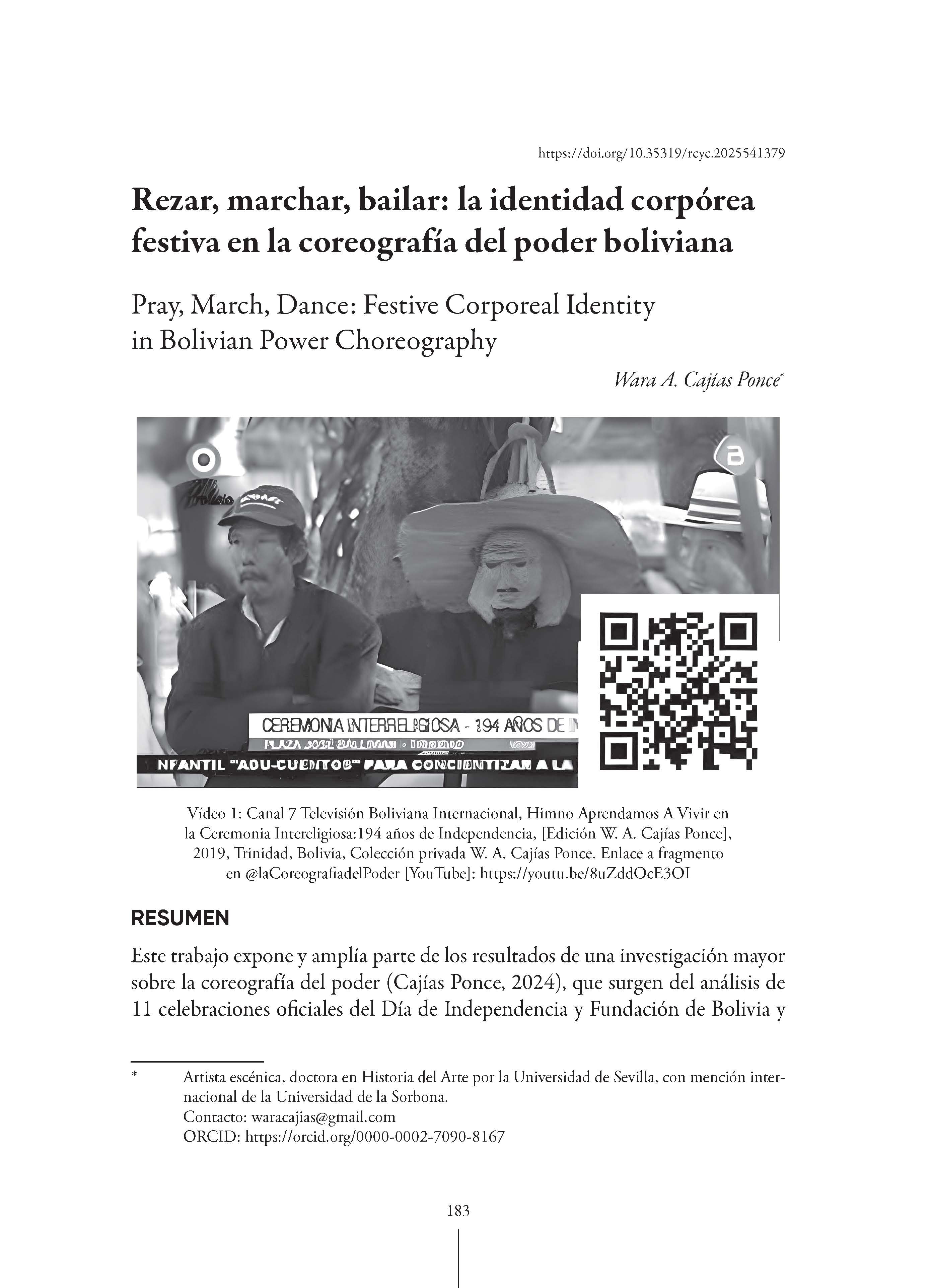Pray, March, Dance: Festive Corporeal Identity in Bolivian Power Choreography
DOI:
https://doi.org/10.35319/rcyc.2025541379Keywords:
Patriotic performances, commemorations, bodily practices, corporeal identities, choreography of power, Independence Day and the Founding of BoliviaAbstract
Th is paper presents and expands on part the results of a larger research on the choreography of power (Cajías Ponce, 2024), which analyses 11 offi cial celebrations of Bolivia’s Independence and Foundation Day and 10 celebrations in the rural Andean area of the same country, between 2009 and 2019. Th e aim of this article is to observe to what extent the actions of praying, marching or dancing are manifested as the triad of festive corporeal identity in these national commemorations and what they reveal about the symbolic construction of nationality in urban and rural contexts.
Downloads
References
Baudrillard, J. (1993[1978]). Cultura y simulacro. Barcelona: Kairós.
Berlin, I. (2000 [19 50-1960]). El sentido de la realidad: sobre las ideas y su historia. Penguin Random House.
Bridikhina, E., Cossío, H.V., Rojas, S. e Mamani, B.M., Vargas, Y., Torrico, I. y calsina S. (2009). La _ esta cívica. Construcción de lo cívico y políticas festivas. Serie Fiesta popular paceña, Tomo IV. Editorial IEB
UMSA.
Bridikhina, E. (2007). Theatrum mundi: Entramados del poder en Charcas colonial. La Paz: Plural. DOI: https://doi.org/10.4000/books.ifea.5420
Cajías Ponce, W.A. (2004). La coreografía del poder. Análisis del espectáculo patriótico a través del caso boliviano [Tes is para Doctorado, Universidad de Sevilla].
Cannadine, D. (2002). Contexto, representación y signi_ cado del ritual: la monarquía británica y la “invención de la tradición”, c.1820-1977. En E. Hobsbawm y T. Ranger (2002). La invención de la tradición (pp. 107-171). Barcelona: Crítica.
Celtis, K. (1934 [1502]). “Quatuor libri amorum secundum quatuor latera Germaniae” En F. Pintdter (ed.), Conradus Celtis Protucius. Quatuor libri amorum secundum quatuor latera Germaniae. Germania Generalis. Bibliotheca Scriptorum Medii Recentisque Aevorum, B.G. Teubner.
Coronel, V. y Prieto, M. (coords.) (2010). Celebraciones centenarias y negociaciones por la nación ecuatoriana. FLACSO Ecuador y Ministerio de Cultura del Ecuador.
Debord, G. (2015 [1967]). La sociedad del espectáculo. España: Pre-Textos.
DECEL, Diccionario etimológico castellano en línea (s/f). rezar. https://etimologias.dechile.net/
Dickson, C. (2016). Dance Under the Swastika: Rudolf von Laban’s In_ uence on Nazi Power. International Journal of Undergraduate Research and Creative Activities, 8,( 1),7. http://dx.doi.org/10.7710/2168-0620.1063 DOI: https://doi.org/10.7710/2168-0620.1063
Fleury, C. (2020). Ci-gît L’amer: Guérir du ressentiment. París: Gallimard.
Gómes Peña, G. y Sifuentes, R. (2011). Exercises for Rebel Artists: Radical Performance Pedagogy. New York: Routledge. https://openlibrary.org/books/OL25041697M/Exercises_for_rebel_artists
Hobsbawm, E., Ranger, T., Trevor-Roper, H., Cannadine, D., Morgan, P. y Cohn, B. (2002[1983]). La invención de la tradición. Barcelona: Crítica.
Hölkeskamp, K. J. (20 23). Theater der Macht. Editorial C.H.Beck.
Karina, L. y Kant, M. (2003): Hitler’s dancers: German modern dance and the Third Reich. New York: Berghahn Books. DOI: https://doi.org/10.2307/j.ctt1x76fgm
Mamani Iñiguez, M. (2009). Creación de un nuevo orden político y prácticas festivas. En E. Bridikhina (coord.), Fiesta cívica. Construcción de lo cívico y políticas festivas (pp .165-179). La Paz: Instituto de Estudios
Bolivianos.
Martínez, F. (2013). Fiestas patrias y cívicas: sus avatares como instrumentos políticos de inclusión-exclusión (1825-1925). Estudios Bolivianos, (19 ), 113-136.
————. (2017). Fêter la nation. Mexique et Bolivie pendant leur premier siècle de vie indépendante (1810-1925). París: Presses Universitaires de Paris Nanterre.
O’Phelan Godoy, S. (1993). Tiempo inmemorial, tiempo colonial: un estudio de casos. Procesos. Revista ecuatoriana de historia, (4) , 3-20. DOI: https://doi.org/10.29078/rp.v1i4.464
Ortemberg,_P. (2012)._Rituels du pouvoir à Lima: de la monarchie à la République (1735-1828)._París, Éditions de l’École des Hautes Études en Sciences Sociales.
Pavis, P. (1998). Diccionario del teatro. Méx ico: Paidó s.
————. (2011). El aná lisis de los espectá culos. México: Paidó s.
Rousseau, J.J. (2012 [1781]). Lettre à D Alembert sur les Spectacles [Carta a D’Alembert sobre los espectáculos]. En Rousseau J.J., Colección completa de obras. Amsterdam: Marc Michel Rey, vol. 6. www.rousseauonline.ch.
Sajewska, D. (2019). Necroperformance: Cultural Reconstructions of the War Body. Diaphanes.
Sch oles, P. (1984). Diccionario Oxford de la música. Barcelona: Edhasa.
Valcárcel, A. (1998). Ética contra estética. Barcelona: Crítica.
———— (2010). La memoria y el perdón. Barcelona: Herder.
Vargas Llosa, M. (2012). La civilización del espectáculo. Madrid: Alfaguara.
Wiltermuth, S. S. y Heath, C. (2009). Synchrony and Cooperation. Psychological Science, 20(1), 1-5. https://doi.org/10.1111/j.1467-9280.2008.02253 . DOI: https://doi.org/10.1111/j.1467-9280.2008.02253.x
Yushkova, E. (2022). Isadora Duncan’s revolutionary performances in Soviet Russia. Shagi/Steps, Rusia, 8(3), 51-84. https://steps.ranepa.ru/jour/article/view/87/0?locale=en_US DOI: https://doi.org/10.22394/2412-9410-2022-8-3-52-84

Downloads
Published
How to Cite
Issue
Section
License
Copyright (c) 2025 Revista Ciencia y Cultura

This work is licensed under a Creative Commons Attribution-NonCommercial 4.0 International License.








